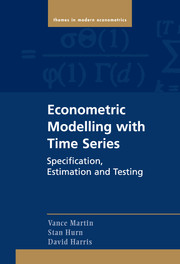Book contents
- Frontmatter
- Contents
- List of Illustrations
- Computer Code Used in the Examples
- Preface
- PART ONE Maximum Likelihood
- PART TWO Regression Models
- PART THREE Other Estimation Methods
- 9 Quasi-Maximum Likelihood Estimation
- 10 Generalised Method of Moments
- 11 Nonparametric Estimation
- 12 Estimation by Simulation
- PART FOUR Stationary Time Series
- PART FIVE Nonstationary Time Series
- PART SIX Nonlinear Time Series
- Appendix A Change of Variable in Density Functions
- Appendix B The Lag Operator
- Appendix C FIML Estimation of a Structural Model
- Appendix D Additional Nonparametric Results
- References
- Author Index
- Subject Index
10 - Generalised Method of Moments
from PART THREE - Other Estimation Methods
Published online by Cambridge University Press: 05 January 2013
- Frontmatter
- Contents
- List of Illustrations
- Computer Code Used in the Examples
- Preface
- PART ONE Maximum Likelihood
- PART TWO Regression Models
- PART THREE Other Estimation Methods
- 9 Quasi-Maximum Likelihood Estimation
- 10 Generalised Method of Moments
- 11 Nonparametric Estimation
- 12 Estimation by Simulation
- PART FOUR Stationary Time Series
- PART FIVE Nonstationary Time Series
- PART SIX Nonlinear Time Series
- Appendix A Change of Variable in Density Functions
- Appendix B The Lag Operator
- Appendix C FIML Estimation of a Structural Model
- Appendix D Additional Nonparametric Results
- References
- Author Index
- Subject Index
Summary
Introduction
The maximum likelihood method of estimation is based on specifying a likelihood function that, in turn, requires specifying a particular form for the joint distribution of the underlying random variables. This requirement is now relaxed so that the model rests only on the specification of moments of certain functions of the random variables, in an approach known as the generalised method of moments (GMM). In the case where the moments used in the GMM procedure correspond to the distribution specified in the maximum likelihood procedure, the two estimators are equivalent. In essence, the choice between maximum likelihood and GMM then boils down to a trade-off between the statistical efficiency of a maximum likelihood estimator based on the full distribution against the ease of specification and the robustness of a GMM estimator based only on certain moments.
GMM is often a natural estimation framework in economics and finance because the moments of a model often correspond to the first-order conditions of a dynamic optimisation problem. Moreover, as theory tends to provide little or even no guidance on the specification of the distribution, computing maximum likelihood estimators requires making potentially ad hoc assumptions about the underlying stochastic processes. This is not the case with using GMM. On the other hand, GMM estimation requires the construction of a sufficient number of moment conditions by choosing instruments that may not be directly related to the theoretical model.
- Type
- Chapter
- Information
- Econometric Modelling with Time SeriesSpecification, Estimation and Testing, pp. 352 - 391Publisher: Cambridge University PressPrint publication year: 2012



